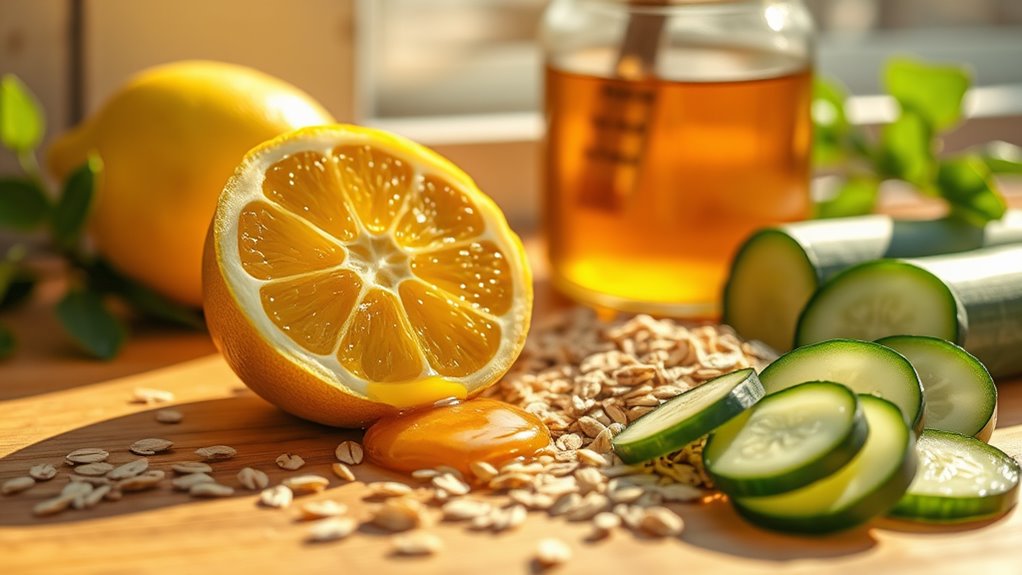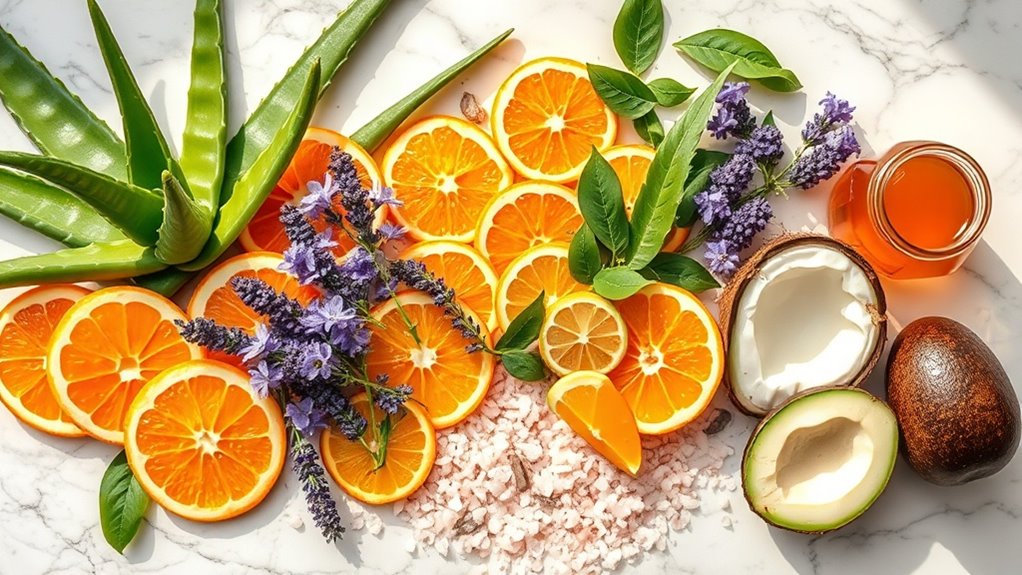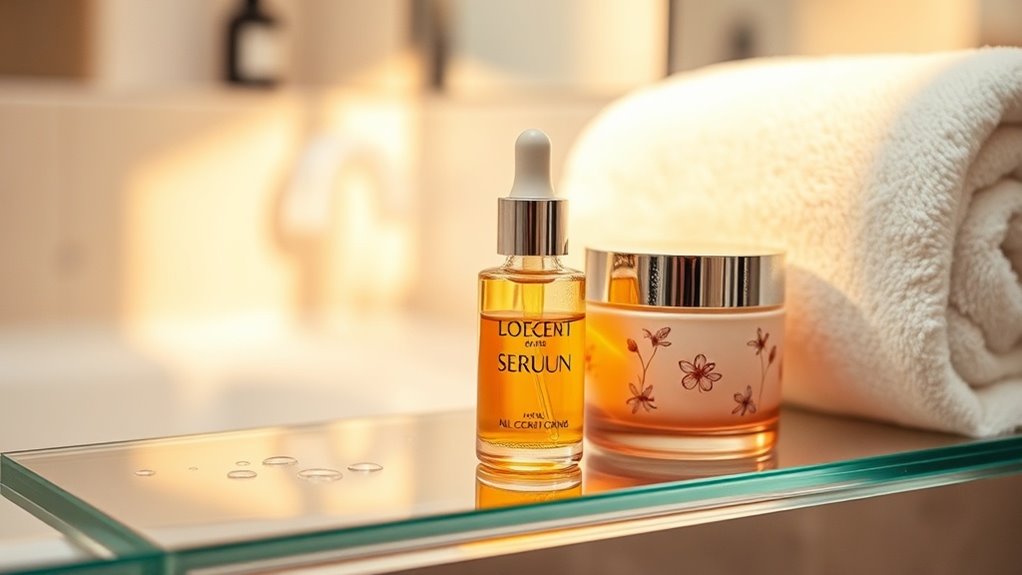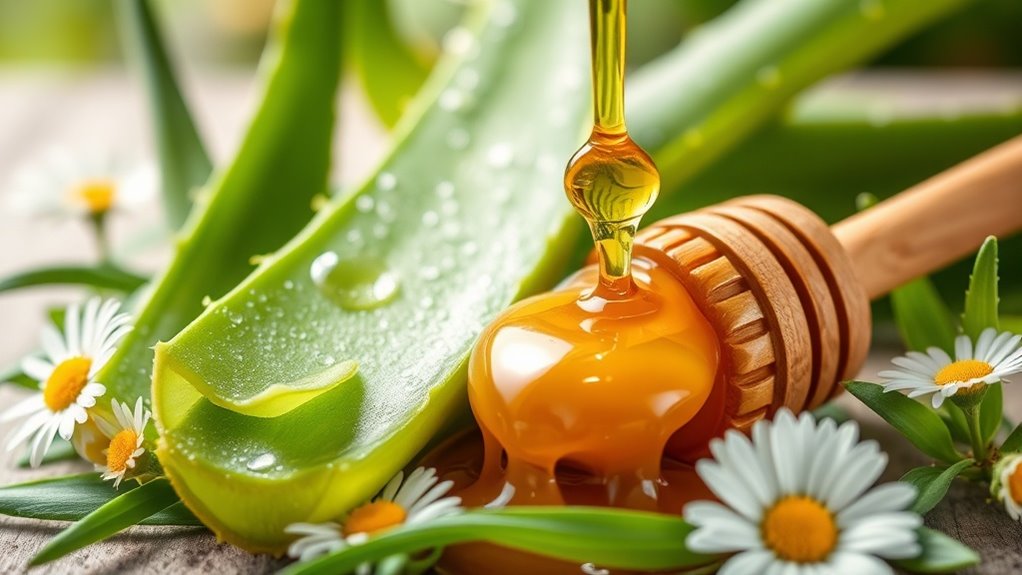Ditch the Chemicals- These Kitchen Ingredients Will Rescue Your Skin
Tired of harsh chemicals? Swap them for kitchen heroes like honey, which soothes and brightens your skin with its antibacterial power, or oatmeal, a gentle exfoliant that sloughs off dead cells without irritation. Coconut oil hydrates deeply, while turmeric calms redness—backed by research on their natural benefits. You’ll feel the difference fast, and there’s plenty more ways these staples can boost your glow.
Key Takeaways
- Use coconut oil as a natural moisturizer to hydrate and nourish dry skin daily.
- Exfoliate gently with oatmeal to remove dead skin cells and soothe irritation.
- Apply honey for its antibacterial properties to reduce redness and enhance glow.
- Brighten skin with lemon juice to fade dark spots and even out tone.
- Tone with apple cider vinegar to balance pH and minimize pores effectively.
Honey for Natural Glow
Honey offers a simple, effective way to achieve a natural glow, thanks to its antibacterial and moisturizing properties.
In nature-based skincare, you harness honey’s natural enzymes to combat blemishes and lock in moisture, drawing from ancient remedies backed by modern research.
You’ll notice reduced redness and smoother texture after regular use, as clinical studies confirm its anti-inflammatory effects.
Apply a thin layer of raw honey to clean skin, let it sit for 10-15 minutes, then rinse with warm water.
This practical approach boosts your skin’s vitality using what’s already in your kitchen.
For enhanced relief from skin irritation, honey can be combined with aloe vera.
Additionally, honey serves as a fast-acting remedy to soothe irritated skin within minutes, making it an ideal choice for immediate relief.
Oatmeal as a Gentle Exfoliant
You can turn oatmeal into a gentle exfoliant that suits your skin’s needs by following simple preparation tips.
It offers proven benefits like removing dead cells and soothing irritation, backed by its natural anti-inflammatory properties. However, excessive use may damage the skin barrier and lead to issues like premature aging.
Now, explore effective application methods to incorporate it into your daily routine.
To enhance results and prevent face washing mistakes, pair oatmeal exfoliation with appropriate water temperature for optimal skin health.
Oatmeal Preparation Tips
Oatmeal’s natural texture makes it an ideal gentle exfoliant, so here’s how to prepare it effectively: grind a handful of rolled oats into a fine powder using a blender or food processor, then mix with water or yogurt to form a paste that won’t irritate sensitive skin.
To make your exfoliant even better, try these tips:
- Choose organic, unprocessed oats to reduce potential irritants and ensure purity.
- Adjust grinding time based on your skin’s sensitivity for a smoother texture.
- Incorporate natural binders like honey to improve paste consistency without drying.
- Test the mixture’s pH with a strip if you have reactive skin for safe application.
Exfoliation Benefits
Exfoliation with oatmeal effectively sloughs off dead skin cells, revealing a smoother, brighter complexion while minimizing irritation.
You’ll appreciate how oatmeal’s natural beta-glucans calm inflammation and strengthen your skin’s barrier, as studies confirm its anti-inflammatory properties reduce acne and redness.
This gentle approach unclogs pores, preventing breakouts and enhancing product absorption, making your routine more effective.
By choosing oatmeal, you’re opting for a cost-effective, evidence-based method that supports long-term skin health without synthetic irritants.
It’s a practical staple for maintaining a balanced, glowing appearance.
Application Methods
To apply oatmeal as a gentle exfoliant, mix finely ground oats with water or a natural hydrator like yogurt for a smooth paste. Gently massage this onto your damp skin in circular motions to slough off dead cells, reducing inflammation as studies show oats’ beta-glucan soothes and protects.
-
Test first: Patch-test on your inner arm to avoid sensitivity, ensuring it’s safe for your skin type.
-
Apply evenly: Use fingertips to cover face and neck, focusing on rough areas for effective, non-abrasive exfoliation.
-
Wait briefly: Leave on for 5-10 minutes to let nutrients penetrate, enhancing your skin’s natural barrier.
-
Rinse carefully: Use cool water to remove residue, then follow with a light moisturizer to lock in hydration and prevent dryness.
Lemon for Skin Brightening
Lemons, packed with vitamin C, brighten your skin by fading dark spots and evening out your tone. This natural acid gently exfoliates, promoting cell turnover and reducing hyperpigmentation from sun damage or acne scars. As part of a DIY solution, lemons provide an accessible and effective natural approach to addressing hyperpigmentation.
To use it safely, mix fresh lemon juice with water or honey, then apply to clean skin for 10 minutes before rinsing. You’ll see results with twice-weekly use, but always patch test first—citric acid can irritate sensitive skin.
For best effects, combine with sunscreen to protect against UV rays, enhancing your skin’s natural glow effectively. Backed by scientific evidence, vitamin C formulations, like those from lemons, have been shown to effectively treat hyperpigmentation for radiant skin.
Turmeric for Soothing Irritation
Turmeric’s anti-inflammatory compounds, like curcumin, effectively soothe skin irritation, drawing from centuries of evidence in traditional medicine.
You can whip up a simple turmeric paste using everyday kitchen items to target redness and inflammation.
Follow this recipe to incorporate it into your skincare routine for noticeable results.
Embracing these kitchen ingredients can lead to long-term skin benefits.
To amplify these effects, combine turmeric with avocados, which provide vitamins E and C to further enhance skin health.
[LIST OF 2 SUBHEADING DISCUSSION POINTS IN ENGLISH
Turmeric effectively soothes skin irritation thanks to its curcumin, a potent anti-inflammatory agent backed by studies.
You’ll reduce redness and swelling naturally, making it a go-to for everyday skin woes. Here’s how to leverage its benefits:
-
Incorporate into your routine: Mix a pinch into your moisturizer for quick relief, as research shows it calms eczema-like symptoms.
-
Target specific areas: Apply diluted turmeric oil directly; studies confirm it eases razor burn within minutes.
-
Boost with black pepper: Add a dash to enhance curcumin absorption, per clinical trials, for better results.
-
Monitor your skin’s response: Start small to avoid staining, ensuring practical, evidence-backed use without side effects.
Turmeric Paste Recipe
One simple way to harness turmeric’s anti-inflammatory power is by making a quick paste at home, which studies show can calm skin irritation effectively.
You’ll need one teaspoon of turmeric powder, a tablespoon of honey, and a dash of water. Mix these into a smooth paste using a spoon—it’s that easy.
Apply the paste directly to irritated skin, let it sit for 10-15 minutes, then rinse with warm water.
Evidence from sources like the Journal of Medicinal Food supports turmeric’s curcumin for reducing redness and swelling. Use it twice weekly for optimal, natural relief.
Coconut Oil for Daily Moisturizing
Coconut oil serves as a versatile, natural moisturizer that effortlessly nourishes your skin daily.
Backed by research, its lauric acid and fatty acids enhance your skin’s barrier, reducing dryness and inflammation while promoting elasticity.
-
Apply a teaspoon nightly: Massage into clean, damp skin for deep hydration and overnight repair.
-
Use on dry areas****: Target elbows, knees, or heels to soothe and soften rough spots effectively.
-
Incorporate into routines: Blend with honey for a quick face mask that boosts moisture retention.
-
Choose virgin types: Select unrefined options to maximize antioxidants and avoid potential irritants.
For an even more effective hydration boost, consider combining coconut oil with hyaluronic acid to lock in moisture and improve skin plumpness.
Using coconut oil can also help differentiate and address dehydrated skin by restoring essential moisture levels and supporting the skin’s barrier function.
Apple Cider Vinegar for Toning
Apple cider vinegar emerges as a reliable natural toner, thanks to its acetic acid content, which helps balance your skin’s pH and minimize pores for a clearer complexion. Additionally, avoiding foods that trigger acne can complement this treatment for overall skin health.
You’ll want to dilute it with water—mix one part vinegar to four parts water—to avoid irritation. Gently apply this solution to your face using a cotton ball after cleansing, then rinse off after a few minutes.
Studies show it fights bacteria and reduces oil, making it ideal for acne-prone skin. Remember, patch test first and use it a few times weekly for best results without over-drying.
Stay consistent for noticeable toning. Additionally, this natural approach can complement overnight acne treatment strategies for faster skin improvements.
Yogurt Masks for Softness
Yogurt masks deliver a gentle way to soften your skin, drawing on its lactic acid to exfoliate and hydrate effectively.
Backed by studies on lactic acid’s role in improving skin elasticity, they’re a practical, chemical-free option that nourishes without stripping natural oils.
-
Choose full-fat, plain yogurt****: Its live cultures and acids gently dissolve dead cells for smoother texture.
-
Mix in a teaspoon of honey: This adds antibacterial properties and boosts hydration for deeper moisture.
-
Apply evenly to cleansed skin: Massage in circles to enhance circulation and maximize absorption.
-
Rinse after 15 minutes: Pat dry and follow with a light oil to seal in softness and maintain the barrier.
Aloe Vera for Healing Properties
Aloe vera stands out as a natural healer for skin irritations, thanks to its rich gel containing anti-inflammatory compounds that reduce redness and promote repair.
You’ll find it eases sunburns and minor wounds by forming a protective barrier that locks in moisture and fights bacteria.
Research supports its efficacy; for instance, studies show it speeds up healing in conditions like eczema.
Simply break off a leaf, extract the gel, and apply it directly to affected areas twice daily.
This kitchen staple empowers you to nurture your skin naturally, minimizing the need for harsh treatments.
Green Tea for Antioxidant Boost
Green tea delivers a potent antioxidant boost that shields your skin from free radicals, thanks to its high levels of catechins like EGCG.
Studies confirm EGCG combats UV damage and inflammation, enhancing your skin’s natural barrier for a radiant glow.
- Brew a strong cup of green tea, cool it, and use as a daily facial spray to neutralize free radicals.
- Combine brewed tea with a teaspoon of matcha powder for a mask that boosts elasticity and fights aging.
- Apply chilled green tea compresses to soothe irritated skin and reduce redness effectively.
- Incorporate green tea into your routine by drinking two cups daily, supporting internal antioxidant defenses for overall skin health.
Avocado for Nourishing Hydration
You can harness avocados’ rich nutrients, like monounsaturated fats and vitamins, to deeply hydrate your skin.
Whip up a simple mask by mashing a ripe avocado with a teaspoon of honey for an effective home treatment.
Applying this mask twice a week leaves your skin feeling moisturized and revitalized.
Avocado Mask Recipe
Avocados, packed with essential fatty acids and vitamins, create a simple yet effective mask for deep skin hydration.
You’ll transform your dry skin into a hydrated haven with this easy recipe, using everyday ingredients for quick results.
- Mash one ripe avocado into a smooth paste for even application.
- Mix in a teaspoon of honey to enhance its soothing properties.
- Apply the mask generously to your clean face and let it penetrate.
- Rinse off after 15-20 minutes with lukewarm water for refreshed, softer skin.
Hydrating Nutrients Inside
Beyond their creamy texture, avocados deliver a potent mix of hydrating nutrients that nourish your skin from within. Packed with monounsaturated fats and vitamin E, these elements strengthen your skin’s moisture barrier, locking in hydration and reducing dryness.
Vitamin C in avocados boosts collagen production, enhancing elasticity and overall glow. Research confirms that regular consumption fights oxidative stress, promoting a healthier complexion.
Make avocados a dietary staple—you’ll notice softer, more resilient skin without relying on harsh chemicals. Stay consistent for lasting results.
Apply for Moisturized Skin
While avocados excel at internal hydration, applying them topically offers a direct way to nourish dry skin. You’ll absorb rich vitamins A, D, and E, plus healthy fats that seal in moisture and combat flakiness, backed by studies showing improved skin elasticity.
-
Mash a ripe avocado: Blend it into a creamy paste for easy application, ensuring even coverage.
-
Mix in extras: Add a teaspoon of honey or yogurt to boost antibacterial properties and hydration.
-
Apply gently: Spread on clean skin, massaging in circles to enhance absorption and circulation.
-
Rinse after 15 minutes: Use lukewarm water to remove, revealing softer, more supple skin for lasting results.





